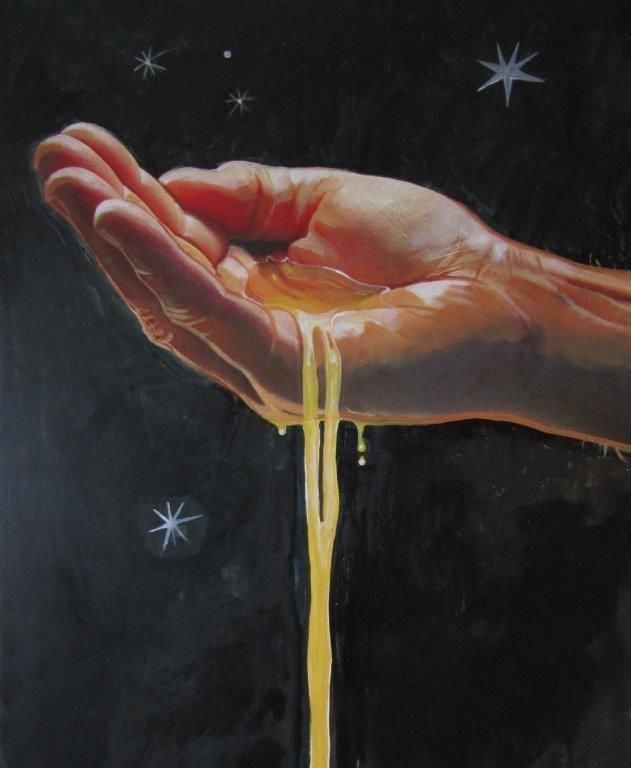Throughout history, nature has whispered divine truths to those who listen. One of the most profound examples is the castor plant, a humble yet extraordinary botanical treasure whose oil has been used for centuries. Reverently known as Palma Christi, or "the palm of Christ," this plant's connection to the sacred transcends its medicinal properties, speaking to the soul of faith and healing.
A Divine Resemblance: The Hand of Christ
The castor plant earned its name Palma Christi due to the unique shape of its leaves, which bear a striking resemblance to an open hand. In Christian tradition, the hand symbolises divine protection, guidance, and blessing. The outstretched hand of Christ is a gesture of love, healing, and invitation - a powerful reminder that He is always reaching out to comfort and restore us. When early Christians looked upon the castor plant, they saw not just a leaf, but the gentle hand of Christ extended toward a weary world.
This resemblance is no mere coincidence. In the language of creation, the hand of Christ is a metaphor for healing, an invitation to surrender our burdens. The castor plant, like the Savior’s hand, offers relief and restoration. Its oil, known for its remarkable healing properties, has been used for everything from soothing aching joints to promoting hair growth. Just as Christ’s touch healed the sick, the Palma Christi offers comfort to those in pain, a living testament to God’s provision.
The Healing Power of Palma Christi
Castor oil’s therapeutic properties are well documented. It is a natural anti-inflammatory, a gentle purgative, and a balm for dry and damaged skin. But beyond its physical benefits lies a deeper spiritual truth: healing is a holistic process that encompasses both body and spirit.
In holy books, Christ’s miracles often involved both physical and spiritual healing. The blind were not only given sight but also hope; the lame were not only made to walk but also set free from their despair. The use of castor oil echoes this duality. When applied to the body, it nurtures and repairs, but it also invites the user to reflect on the deeper healing that only God can provide. In anointing ourselves with the oil, we remember the anointing of the Holy Spirit, who comforts, cleanses, and renews.
Historical Context and Traditional Use
Castor oil’s long-standing presence in human culture reveals its lasting importance. It has been utilised for over 4,000 years, with historical evidence indicating its use in ancient Egypt for a variety of purposes, including as a lamp oil and in cosmetics. The ancient Egyptians even applied it as a salve for skin and to promote hair growth. Its roots in the Holy Land also point to its symbolic and practical uses in biblical times. References to oil as a symbol of consecration, healing, and divine favour appear frequently in both the Old and New Testaments. Oil was used in the anointing of prophets, priests, and kings, and is a vital symbol in Christian sacraments of healing and blessing.
Other religious traditions also place deep significance on oil and anointing. In Hinduism, sesame, coconut, and other sacred oils are used in rituals and self-massage practices (Abhyanga) to purify the body, improve circulation, and create a meditative connection with the divine. In Judaism, olive oil has been used for ceremonial anointing of kings, priests, and the sacred objects of the temple, symbolizing dedication, healing, and divine favour. In Islam, oils such as black seed and olive oil are recommended in prophetic traditions (Hadith) for both their spiritual and medicinal properties, emphasizing the holistic care of body and soul.
Modern religious and spiritual practices often incorporate oils like castor oil as a tangible way to embody faith. Applying the oil mindfully can become an act of prayer, meditation, or intention setting. Each stroke of oil on the skin becomes a reminder of the divine presence, a blessing of health, and a commitment to self-care as an expression of spiritual practice.

Studies and Research: The Scientific Validation of Palma Christi
In recent years, scientific studies have highlighted the numerous health benefits of castor oil, adding credibility to its long-standing reputation as a natural remedy. Several studies have investigated its various therapeutic properties:
-
Anti-inflammatory Properties: Research has shown that castor oil has significant anti-inflammatory effects, making it effective for treating conditions like arthritis, muscle pain, and other inflammatory disorders. One study published in the Journal of Ethnopharmacology found that castor oil significantly reduced inflammation in animal models, supporting its traditional use for joint pain and muscle aches (https://www.ncbi.nlm.nih.gov/pmc/articles/PMC1781768/)
-
Wound Healing: Castor oil’s ability to promote tissue growth and accelerate healing has been well-documented in clinical studies. In one study published in the International Journal of Molecular Sciences, researchers noted that castor oil significantly improved wound healing by stimulating the growth of new tissue and supporting the formation of collagen (https://www.ncbi.nlm.nih.gov/pmc/articles/PMC3793844)
-
Antimicrobial Effects: Castor oil has demonstrated antimicrobial properties, making it effective in treating infections and preventing bacterial growth. A study published in the Journal of Applied Microbiology showed that castor oil has a strong antibacterial effect against various pathogens, including Staphylococcus aureus and Escherichia coli (https://www.ncbi.nlm.nih.gov/pmc/articles/PMC4919163/)
-
Hair Growth: Numerous anecdotal reports and studies support castor oil’s ability to stimulate hair growth. It is believed that its high ricinoleic acid content increases blood flow to the scalp, stimulating hair follicles. A study published in the Journal of Clinical and Aesthetic Dermatology found that topical application of castor oil led to improved hair growth in individuals with hair loss (https://www.ncbi.nlm.nih.gov/pmc/articles/PMC4387693/)
These studies reinforce the notion that castor oil’s healing properties are not merely symbolic but have a real, tangible effect on the body. Castor oil continues to bridge the gap between faith and science, with both traditional beliefs and modern research supporting its role in holistic healing.
The Spiritual Symbolism of Oil
Oil has long been a symbol of anointing, consecration, and divine favor in many religious traditions. In the Old Testament, priests and kings were anointed with oil as a sign of their divine calling. In the New Testament, Christ Himself is referred to as the Anointed One. Castor oil, as the Palma Christi, can serve as a modern symbol of this ancient practice. It reminds us that we, too, are called to be anointed vessels of God’s love, bringing healing and peace to those around us.
In Hindu, Jewish, and Islamic traditions, oil is used in ritual and devotional practices as a conduit for spiritual energy, prayer, and mindfulness. Applying castor oil in these contexts can serve as both a symbolic and practical tool, connecting faith, body, and mind. The act of anointing becomes a tangible practice of devotion, a daily reminder to care for oneself as an extension of one’s faith.
A Call to Reflection and Healing
The next time you encounter castor oil, pause for a moment. Reflect on its ancient name, Palma Christi, and consider the hand of Christ - or, in broader spiritual terms, the presence of divine healing - reaching out to you. Allow it to be a reminder that healing is not just a physical process but a spiritual journey. In the simple act of anointing your body with oil, you participate in an ancient tradition of trust in divine providence, inviting peace, blessing, and restoration into your life.
Whether it is used for its therapeutic effects or as a symbolic gesture, castor oil offers both physical and spiritual restoration - a tangible reminder of the ever-present, loving hand of the divine. In this expanded reflection on Palma Christi, we see the deep connection between faith, tradition, and science. Castor oil, with its ancient symbolism and modern healing properties, continues to serve as a bridge between the sacred and the physical world, offering restoration for body, mind, and spirit.
How iAMA products can help you
Our iAMA Castor Oil-powered skincare, haircare, and beauty products offer a unique alignment; our products are 100% natural, organic, and free from harmful chemicals, they honor the principle of stewardship over one’s body - a concept shared across many faith traditions.
Using our castor oil products as part of daily self-care can be viewed as a mindful, intentional practice, almost like a modern ritual: anointing your skin and hair becomes an act of reverence, gratitude, and respect for the body as a sacred vessel. From promoting healthy skin and hair to supporting overall wellness, our castor oil products allow religious individuals to care for themselves in a way that complements prayer, meditation, and spiritual reflection, creating harmony between physical health, spiritual practice, and mindful beauty routines.
iAMA is the home of pure gold, pure Castor Oil.
Shop Castor Oil gold www.iamawellness.com
Contact us by emailing contact@iamawellness.com
Follow us on Instagram @iamawellness






